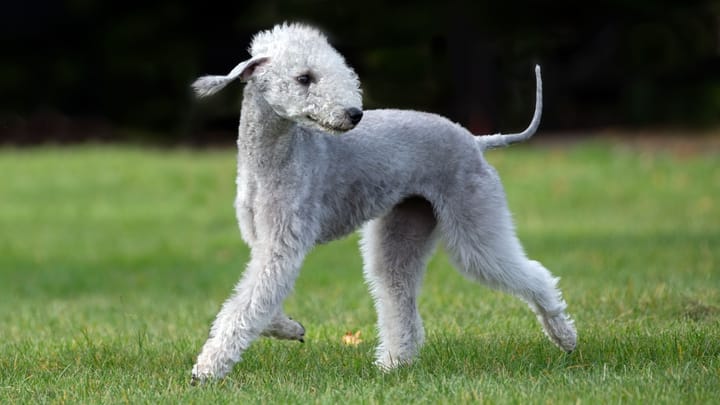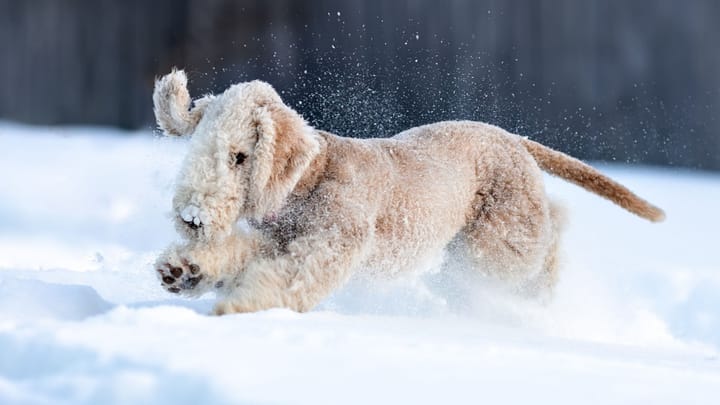Bedlington Terrier
Other names : Rothbury Terrier, Linty-haired Terrier, Rothbury's Lamb


A loyal and friendly breed is the Bedlington Terrier. However, instances of problem behaviour have been reported in relation to the dog’s interaction with other household pets and children. Thus, socialisation is an essential part of ownership of the breed. Worthwhile training and regular (gentle) reminders of who is the ‘top dog’ at home will prevent the Bedlington from taking charge.
|
Life expectancy |
The Bedlington Terrier has a life expectancy of between 12 and 14 years |
|
Temperament |
|
|
Size |
Medium
|
|
Adult size |
Female
Between 13 and 17 in
Male
Between 14 and 18 in
|
|
Adult weight |
Female
Between 18 and 22 lb
Male
Between 18 and 22 lb
|
|
Coat colour
Bedlington Terriers are found in colours of Liver, Blue and Sandy and usually marked with other marking patterns called tan points; as the dog grows up most of its marking patterns blend into the overall colour of its coat. |
Brown Blue Sand |
|
Type of coat
Short and shaggy. This dog's coat comprises a mixture of hard and soft hairs not unlike that of a poodle. The coat is hard and rugged but is also described as ‘linty’ since it also contains short and fine hairs. |
Hard Wavy |
|
Eye colour
Amber/hazel. |
Brown
|
|
Purchase price |
The Bedlington Terrier costs between £410 and £650 |
Do not berate any dog and especially not a terrier. If you berate a dog such as the Bedlington and do so more harshly than is required you are liable to cause the dog to snap back at you.
More details about the Bedlington Terrier
Bedlington Terrier: Origins and history
The Bedlington Terrier was originally bred in the countryside surrounding the small northern English town of Bedlington. Its role in the human world has included rat catcher, racer, fighter and show dog. It is these days more of a companion dog but it retains the resilience and fighting prowess of yesteryear.
Physical characteristics of the Bedlington Terrier
The Bedlington Terrier has a sheep-like appearance mostly due to its woolly coat. Its eyes are small and sunken into a narrow and rounded skull. On top of the head of the Bedlington is a topknot of silky, linty hair. The dog’s muzzle is long and slender and its teeth are scissor-like. The ears hang flat against the dog’s cheeks.
FCI classification of the Bedlington Terrier
-
Group 3 - Terriers
-
Section 1 : Large and medium sized Terriers
Bedlington Terrier: Characteristics
Bedlington Terrier: Behaviour
Training a Bedlington Terrier
Bedlington’s do not appreciate being told what to do so training should be forceful yet not overly harsh. Be confident and consistent when training your dog and keep lessons varied. A Bedlington’s intelligence can itself be a challenge to control and to manage.
Bedlington Terrier: Lifestyle
Breed compatibility Bedlington Terrier
Bedlington Terrier: Purchase price
The price for a Bedlington Terrier varies according to their gender, age and origins. If this dog is registered at the Kennel Club, the price can approximately be £650.
The average monthly budget to care for a Bedlington Terrier varies between £100 to £140.
Bedlington Terrier: Shedding
Light
This breed’s coat is light-shedding but it is not non-shedding.
Bedlington Terrier: Grooming
Bedlingtons should be brushed two to three times a week and have a professional groom every two months. If the dog is not groomed regularly, the condition of its coat rapidly deteriorates. Clipping a Bedlington to anything more than a ‘pet groom’ is very time-consuming and expensive.
Bedlington Terrier: Health
14 to 16 years.
The Bedlington Terrier is a hardy and resilient dog that has been successfully bred as a pedigree for generations.
The Bedlington will not tolerate hot weather. Its thick woolly coat causes the dog to be particularly unhappy during the summer months.
The woolly coat of the Bedlington keeps the dog warm even in the snow.
Weight gain is seen of some Bedlingtons; these dogs have a huge appetite and will eat to obesity. However, others are very particular about their diet and get sick quite easily on new food or by eating too fast.
- Copper toxicosis
- Distichiasis
- Entropion
- Imperforate Nasolacrimal Puncta






